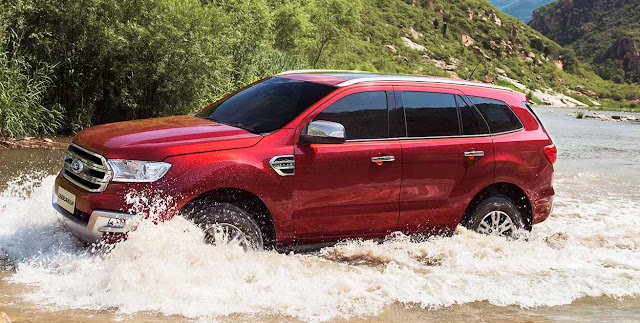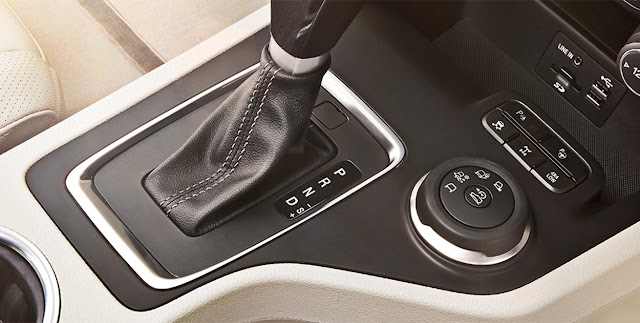Off-Road Driving Tips by Richard Woolley & Nick Allen, the engineers behind the New Ford Endeavour
1. Be prepared
Off-road driving presents a range of challenges. Reduce the risks by thoroughly planning your journey and carrying a few essentials. A full fuel tank, a tow rope, a shovel, a spare tire and tire-changing kit, a portable air compressor, a map and compass (or a GPS unit), and a mobile or satellite phone are basics. Always travel in a convoy, so that that there are other vehicles available to assist with recovery, if required.
2. Get to know your vehicle
Get a feel of your vehicle and understand how it behaves in different scenarios. Learn to engage specific features and technologies that are designed to aid in off-road environments. For instance, the new Ford Endeavour has a low-range setting and an electronic locking rear differential that you should learn how to engage and disengage before driving in extreme off-road conditions. Understand the technology in your vehicle, and be familiar with its dimensions and capabilities. You may have to squeeze through tight spaces, wade through water, or climb over challenging obstacles. In these cases you will need to know your vehicle’s width, water wading abilities, ground clearance, and approach and departure angles.
3. Reduce your tire pressure
How much you reduce your tire pressure will vary depending on where you are driving. So be sure to check the optimal tire pressure for the specific terrain. This simple trick greatly improves the vehicle’s off-roading performance and comfort level in the cabin. It allows more of the tire to touch the ground so that the weight of the vehicle is more evenly distributed. This helps you to stay on top of softer surfaces like sand or mud. The tires can also absorb more impact, which helps to protect the wheels and the rest of the vehicle in rocky terrains. The drive experience is smoother and more comfortable, as the deflated tires absorb smaller bumps instead of bouncing over them. Keep in mind to avoid sharp turns, as the chances of under-inflated tires detaching from the wheel are higher. Remember to re-inflate the tires before you get back on the road. Using under-inflated tires for regular road driving reduces vehicle safety, the life-span of tires and fuel efficiency.
4. Use low range, or the lowest gear available
Keeping the vehicle in low range gives you more control and power at low speeds. Increased control is what you require when you are driving over highly technical or rocky terrain with reduced traction, or when tackling steep descents and ascents. With the new Endeavour, low range can be manually engaged when the vehicle is stationary with the flick of a switch, and also works in conjunction with the Terrain Management System’s (TMS) rock mode, which gives you maximum control when you need it most.
5. Drive as slowly as possible
Driving quickly means you will have less time to react if something goes wrong, and it will take longer to stop. High speeds will also increase the damage to your vehicle when driving over obstacles or if you collide with anything. Driving slowly lets your vehicle’s suspension absorb most bumps for a more comfortable ride. It will also give you more time to examine your surroundings, and anticipate and react to situations. Some obstacles might require more speed to tackle, such as steep ascents, but most obstacles need little more than a walking pace. Drive as slowly as possible, while still driving fast enough to overcome the ascent. If you find you are driving too slowly, it’s easy to step on the accelerator, but if you are driving too quickly, you may face more risks and find it difficult to safely correct.
6. Choose the best line
Look at the terrain ahead of you and try to ascertain the safest route. There are often multiple ways to overcome an obstacle, and it is important to choose the route that poses the least risk. To avoid potentially damaging the underneath of your vehicle, choose a line that ensures all four wheels maintain contact with the ground. If the path ahead is particularly narrow, steep, or has large objects that you can’t see around, engage a friend as a “spotter”, who can get out of the vehicle and help guide you through these sections.
7. Approach water crossings with caution
Before taking on any major water crossing, be aware of your vehicle’s water wading ability. The Endeavour can wade through water up to 800mm deep which is achieved travelling at a steady speed of no more than 7 km/h. When approaching a water crossing, it is a good idea to get out of your vehicle to measure the depth of the water ahead either with a stick or by walking through the section that you plan to cross. Needless to say, if the water is deeper than your vehicle’s water wading ability, you need to find another path. When assessing the water’s depth, lookout for potential submerged hazards such as large rocks or holes. If the water looks safe to cross, enter slowly (walking pace) to prevent an excessive bow wave over the hood of the vehicle. Once moving it is important to maintain your speed, as stopping in deep water can cause components of the vehicle to flood.
8. Understand how to drive in different terrains
Different terrains call for different driving techniques. The TMS modes in the new Endeavour optimizes performance for different conditions. Here’s how they work:
Sand
When driving in terrains with deep sand, the key to successful off-roading is to maintain your momentum and keep your engine RPMs high. If you slow down too much or don’t keep the wheels moving, you run the risk of sinking into the sand. Sand mode in the Endeavour helps maintain momentum with transmission upshifts much later and downshifts earlier, to keep the engine RPMs high. It also reduces the traction control intervention to allow the wheels to keep spinning, and increases the sensitivity of the throttle so that small foot movements have a much greater impact on the speed. When parking in deep sand, you should always allow your vehicle to roll to a stop. This prevents the wheels from digging into the sand when the brakes are applied so that it is easier to get moving again. Another tip to help you drive away with ease is to always park on either a flat surface or with the vehicle pointing slightly downhill.
Snow, Mud, Grass
When driving on slippery or loose surfaces, such as mud, gravel, wet grass, snow or ice, the priority should be to keep the vehicle under control to avoid a loss of traction. When using Snow, Mud, Grass mode, the Endeavour’s transmission upshifts early and downshift late to help keep the engine from revving too high. It will also increase traction control intervention to reduce wheel slip and reduce the sensitivity of the throttle to give more precise control over speed.
Rock
For rocky terrain, maximize your control at very low speeds. This will help you to climb over large rocks without damaging the vehicle, and will allow the suspension to absorb impacts more effectively. Rock mode requires you to place the vehicle in low-range four-wheel drive to give you better control at low speeds. The traction control is designed to intervene aggressively in order to stop the wheels from spinning when climbing over large rocks. Rock mode also makes the throttle much less sensitive so that bumps in the road don’t cause you to accidentally press the accelerator and accelerate too quickly.
9. Remember that it’s OK to turn around
Even when using Terrain Management System, the driver remains responsible for assessing suitability of off-road terrain. If you are not confident in your ability to navigate the terrain ahead of you, either find another way around or go back the way you came. Safety is always the most important factor when driving off-road. If you ever feel unsafe or uncertain, there is no shame in turning your vehicle around.
10. Notify friends/relatives of your proposed plan and dates
It is important to make sure your friends and families know your plans and your proposed route when you travel off the beaten track. Make sure you share your proposed plans, especially if you’re heading into inaccessible areas with little or no mobile phone coverage. Also ensure you check in with the local authorities on the conditions and expected conditions prior to undertaking your trip.
11. Familiarize yourself with the legal requirements of the areas
Before you set off, it is important to make sure you’re familiar with any specific rules or regulations concerning the country you’re travelling through, particularly if it’s through national parks. Some off-road desert driving requires flags to be fitted to vehicles to maintain visibility to other off-road users.
“Off-roading is a life-long passion, and there is always more to learn,” says Woolley. “But if you follow these tips, you will be safer and more successful on your first foray into the world of off-road driving.”
So go ahead and take the challenge. And stay safe.
Pictures courtesy: www.india.ford.com





Sanjay Sarma
April 20, 2016 at 4:38 pm
time to take that trip.